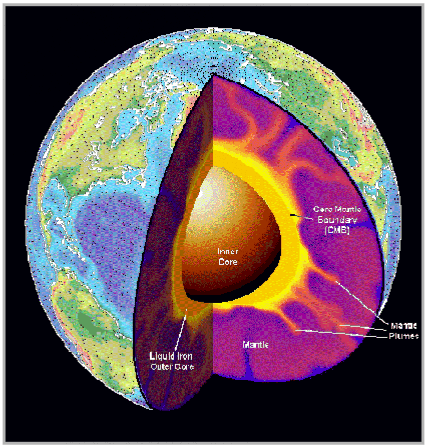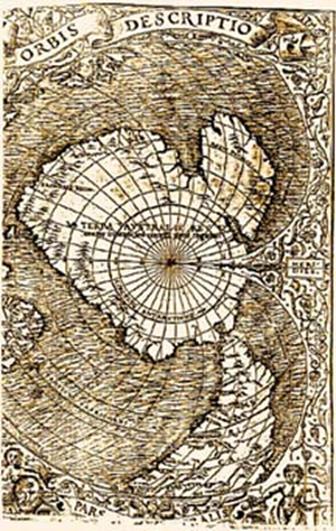Thousands of animals were found to be frozen in a brief moment of geological time. Ancient maps of Antarctica suggests that it too was 'frozen over' in a brief moment in time.
It has been suggested that approximately 12,000 years ago there was a displacement of the Earth's crust. The entire outer shell of the earth moved approximately 2,000 miles. When the Earth's crust shifted all of Antarctica was encapsulated by the polar zone. At the same time North American was His theory is based on the theory of Continental Drift - the continents of the earth have been slowly drifting apart over millions of years. This is possible because the outer crust of the Earth floats upon a semi-liquid layer. The theory of Crustal Displacement states that the entire crust of the Earth can shift in one piece like the lose skin of an orange.
Prof. Hapgood who created this theory documented three Earth crust displacements in the last 100,000 years. Some researchers believe that they happen every 41,000 years and that the last one happened 11,500 years ago. Hapgood believes that this cataclysmic shift is caused by imbalanced ice at the polar caps. Over time ice builds up at the poles reaching as much as two miles in thickness. from the Arctic Circle and became temperate.
The tremendous weight of the ice causes an imbalance on the globe. The ice shifts dragging the outer crust and the continents in one piece to new positions. The polar caps are now in a warmer climate where they begin to melt. The polar regions are now in a temperate climate where they begin to melt where temperate regions are in the polar regions where they freeze and build up ice.
Charles H. Hapgood was a history professor who began, at the prompting of some students, to look into the search for the lost continent of Atlantis. That lead him to the ideas of Hugh Achincloss Brown: that the entire earth could be made to be repositioned at a radically new angle on its axis of rotation.
Hapgood realized that the entire planet did not have to be repositioned around its axis. Only the outer crust need move, just as the loosely peeled skin of an orange could be slid around the unmoved inner slices. This line of thinking was published in Earth's Shifting Crust (1958), in collaboration with James H. Campbell, a mathematician-engineer.
Hapgood ultimately revised key parts of his thinking because his calculations convinced him that the mass of the ice cap on Antarctica could not destabilize the earth's rotation.
This is the Oronteus Finaeus World Map of 1532 - showing Antarctica.
Hapgood and his team converted this map from its current projection method into a modern projection method.
Compare the above with a modern map of Antarctica to see at a glance just how close they were.
This demonstrates that sometime in the history of the earth, before at least the 1500's a sea faring people existed that could circumnavigate the globe and accurately survey its features.
Atlantis, Mammoths, and Crustal Displacement
Rand Flem-Ath and Graham Hancock all write that an unknown advanced civilization existed on the Antarctica continent and was destroyed by cataclysmic shifting of the crust of the Earth.
Rand and Rose Flem-Ath in their book When the Sky Fell claim that the lost advanced civilization of Graham Hancock was Atlantis based upon a very liberal, loose, and speculative interpretation of the myth of Atlantis as told by Plato. Regardless of whatever a person chooses to call it, the main claim is that the remains of advanced, lost technological civilization lie buried beneath Antarctica.
One has to wonder - if such a civilization existed, why have the ruined cities, infrastructure, and other artefacts of a lost advanced civilization that made the source maps for the Piri Reis, Oronteus Finaeus, and Buache maps and inspired megalithic architecture not been found?
According to Graham Hancock Fingerprints of the Gods and Rand Flem-Ath, the solution is that the remains of this civilization lie buried beneath the Antarctic ice cap where it was destroyed and buried by Earth crustal displacement.








